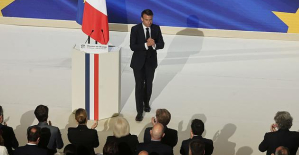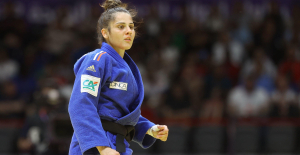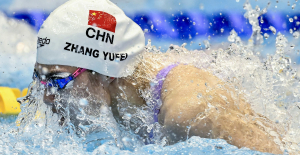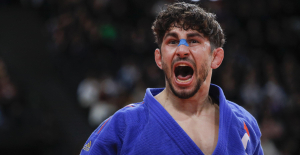“Two assholes come in the door”. This crude sentence is not the beginning of a bad joke, but the title of a picture that is currently hanging in the Kunsthalle Düsseldorf. Martha Jungwirth painted it. With fast, furious brushstrokes, the artist sketched an encounter with two men from the art world in her Vienna studio.
Martha Jungwirth is an accomplished painter with a lot of temperament. This is not only shown by the title of the double portrait with the two A-men, but is also reflected above all in the way in which their broad oeuvre, of which around 90 works from the past 60 years can now be seen, is designed.
What is noticeable at first glance: the colors on the paintings are applied quickly and precisely, the lines are powerful and secure. The artist masters a large format such as the triptych “Memorial I” with the same power as the small “beetle creature”. At the age of 82, she has created an oeuvre that need not fear comparison with the stars of the art scene of her generation, such as Gerhard Richter, Richard Serra or Yayoi Kusama.
And yet it is still unknown to the general public. All you need to do is take a look at their exhibition catalogue. It has only been recognized internationally since 2010. At that time, the artist Albert Oehlen curated an exhibition in the Museum Essl in Klosterneuburg, Austria, in which he dedicated a separate room to Jungwirth's works. Since then, the interest of museums and renowned galleries has grown and grown - the list features London, Athens, Zurich, Paris, New York and Tokyo.
Martha Jungwirth has not hidden herself in recent years. Since her studies at the University of Applied Arts in Vienna, she has constantly painted and done watercolors. The start of her career was promising. At the age of 21, she was honored with the Otto Maurer Prize, an award for young artists that was well respected in the scene. And just four years later, the then 25-year-old was invited to Documenta 6 in Kassel.
One would have thought that this would be the perfect starting position for a successful career. But the artist became quiet. "Some already knew that my work is good," Martha Jungwirth recently told the TV channel "Arte". She had two or three collectors, but overall her work was not tolerated in Austria. "Everything takes a long time in Austria," is her summary. And in the rest of the world, too, one would have to add.
Art gallery director Gregor Jansen only got to know Jungwirth's expressive paintings three years ago in a New York gallery. The power that emanates from these works captivated him so much that he immediately contacted the artist, says Jansen. "I haven't seen such self-confident, independent painting for a long time."
What is so unique about Martha Jungwirth's art? What makes them so attractive to us today that museums and gallery owners are clamoring for them? The keyword is good painting. Martha Jungwirth consistently follows her own style and has perfected it over the decades. There are essentially three parameters that characterize her handwriting.
On the one hand there is the pleasure in depicting figures and objects. Different motifs such as people, landscapes, bouquets of flowers, sometimes also from ancient mythology and animals can be found in her pictures; such as “Francisco de Goya. The Dog or The Trojan Horse. "Lady Gaga" is also worth a portrait for her, the singer is fixed with brisk strokes. However, Jungwirth's figures are not reproduced one-to-one, but abstracted. “I invent a painterly language, an equivalent to the rigid realistic world. 20 percent is enough to recognize a few objects,” she describes her working method in a poem.
The second strong pillar is color. Above all, it is the diverse shades of red and the aggressive yellow that cheekily play their way to the fore. Impasto presses, strokes and wipes the oil paints on the cardboard-like painting surface. The energetic application is decisive for the effect of the pictures. "Painting a picture has to be done in one go, fast and body-focused," she explains of her working method. A quick eye and good footwork are important. Good footwork? One imagines how Jungwirth dances back and forth in front of the screen and uses strokes of color in the process. Jungwirth's world is all about painting. She wants "no metaphysics, no occultism, no philosophy," as she writes.
A special feature of this Düsseldorf show is the “Corona Diary” series. There are smaller works on cardboard in which the painter captures her immediate surroundings during the lockdown - like the view from her yellow "Corona prison". One senses how such crisis works are less sketchily pointed and more two-dimensional, melancholic.
There is one major change at Jungwirth. Those are the formats. The triptych "Tutankhamun" measures an impressive nine meters in length, and the beautiful "Maja I" lolls on a canvas of around three meters. The fact that the artist has been able to work in this format for several years is a result of her (financial) success, which not only drew her more attention, but also enabled her to move into a larger studio.
For Martha Jungwirth, her – albeit late – recognition is a stroke of luck. She recently revealed to "Arte": "Hopefully I'll be able to hold out for a while longer in terms of health".
Exhibition: Martha Jungwirth in the Kunsthalle Düsseldorf; until 20.11.

 Hamas-Israel war: US begins construction of pier in Gaza
Hamas-Israel war: US begins construction of pier in Gaza Israel prepares to attack Rafah
Israel prepares to attack Rafah Indifference in European capitals, after Emmanuel Macron's speech at the Sorbonne
Indifference in European capitals, after Emmanuel Macron's speech at the Sorbonne Spain: what is Manos Limpias, the pseudo-union which denounced the wife of Pedro Sánchez?
Spain: what is Manos Limpias, the pseudo-union which denounced the wife of Pedro Sánchez? Spain is the country in the European Union with the most overqualified workers for their jobs
Spain is the country in the European Union with the most overqualified workers for their jobs Parvovirus alert, the “fifth disease” of children which has already caused the death of five babies in 2024
Parvovirus alert, the “fifth disease” of children which has already caused the death of five babies in 2024 Colorectal cancer: what to watch out for in those under 50
Colorectal cancer: what to watch out for in those under 50 H5N1 virus: traces detected in pasteurized milk in the United States
H5N1 virus: traces detected in pasteurized milk in the United States Private clinics announce a strike with “total suspension” of their activities, including emergencies, from June 3 to 5
Private clinics announce a strike with “total suspension” of their activities, including emergencies, from June 3 to 5 The Lagardère group wants to accentuate “synergies” with Vivendi, its new owner
The Lagardère group wants to accentuate “synergies” with Vivendi, its new owner The iconic tennis video game “Top Spin” returns after 13 years of absence
The iconic tennis video game “Top Spin” returns after 13 years of absence Three Stellantis automobile factories shut down due to supplier strike
Three Stellantis automobile factories shut down due to supplier strike A pre-Roman necropolis discovered in Italy during archaeological excavations
A pre-Roman necropolis discovered in Italy during archaeological excavations Searches in Guadeloupe for an investigation into the memorial dedicated to the history of slavery
Searches in Guadeloupe for an investigation into the memorial dedicated to the history of slavery Aya Nakamura in Olympic form a few hours before the Flames ceremony
Aya Nakamura in Olympic form a few hours before the Flames ceremony Psychiatrist Raphaël Gaillard elected to the French Academy
Psychiatrist Raphaël Gaillard elected to the French Academy Skoda Kodiaq 2024: a 'beast' plug-in hybrid SUV
Skoda Kodiaq 2024: a 'beast' plug-in hybrid SUV Tesla launches a new Model Y with 600 km of autonomy at a "more accessible price"
Tesla launches a new Model Y with 600 km of autonomy at a "more accessible price" The 10 best-selling cars in March 2024 in Spain: sales fall due to Easter
The 10 best-selling cars in March 2024 in Spain: sales fall due to Easter A private jet company buys more than 100 flying cars
A private jet company buys more than 100 flying cars This is how housing prices have changed in Spain in the last decade
This is how housing prices have changed in Spain in the last decade The home mortgage firm drops 10% in January and interest soars to 3.46%
The home mortgage firm drops 10% in January and interest soars to 3.46% The jewel of the Rocío de Nagüeles urbanization: a dream villa in Marbella
The jewel of the Rocío de Nagüeles urbanization: a dream villa in Marbella Rental prices grow by 7.3% in February: where does it go up and where does it go down?
Rental prices grow by 7.3% in February: where does it go up and where does it go down? “Deadly Europe”, “economic decline”, immigration… What to remember from Emmanuel Macron’s speech at the Sorbonne
“Deadly Europe”, “economic decline”, immigration… What to remember from Emmanuel Macron’s speech at the Sorbonne Sale of Biogaran: The Republicans write to Emmanuel Macron
Sale of Biogaran: The Republicans write to Emmanuel Macron Europeans: “All those who claim that we don’t need Europe are liars”, criticizes Bayrou
Europeans: “All those who claim that we don’t need Europe are liars”, criticizes Bayrou With the promise of a “real burst of authority”, Gabriel Attal provokes the ire of the opposition
With the promise of a “real burst of authority”, Gabriel Attal provokes the ire of the opposition These French cities that will boycott the World Cup in Qatar
These French cities that will boycott the World Cup in Qatar Judo: Blandine Pont European vice-champion
Judo: Blandine Pont European vice-champion Swimming: World Anti-Doping Agency appoints independent prosecutor in Chinese doping case
Swimming: World Anti-Doping Agency appoints independent prosecutor in Chinese doping case Water polo: everything you need to know about this sport
Water polo: everything you need to know about this sport Judo: Cédric Revol on the 3rd step of the European podium
Judo: Cédric Revol on the 3rd step of the European podium


















